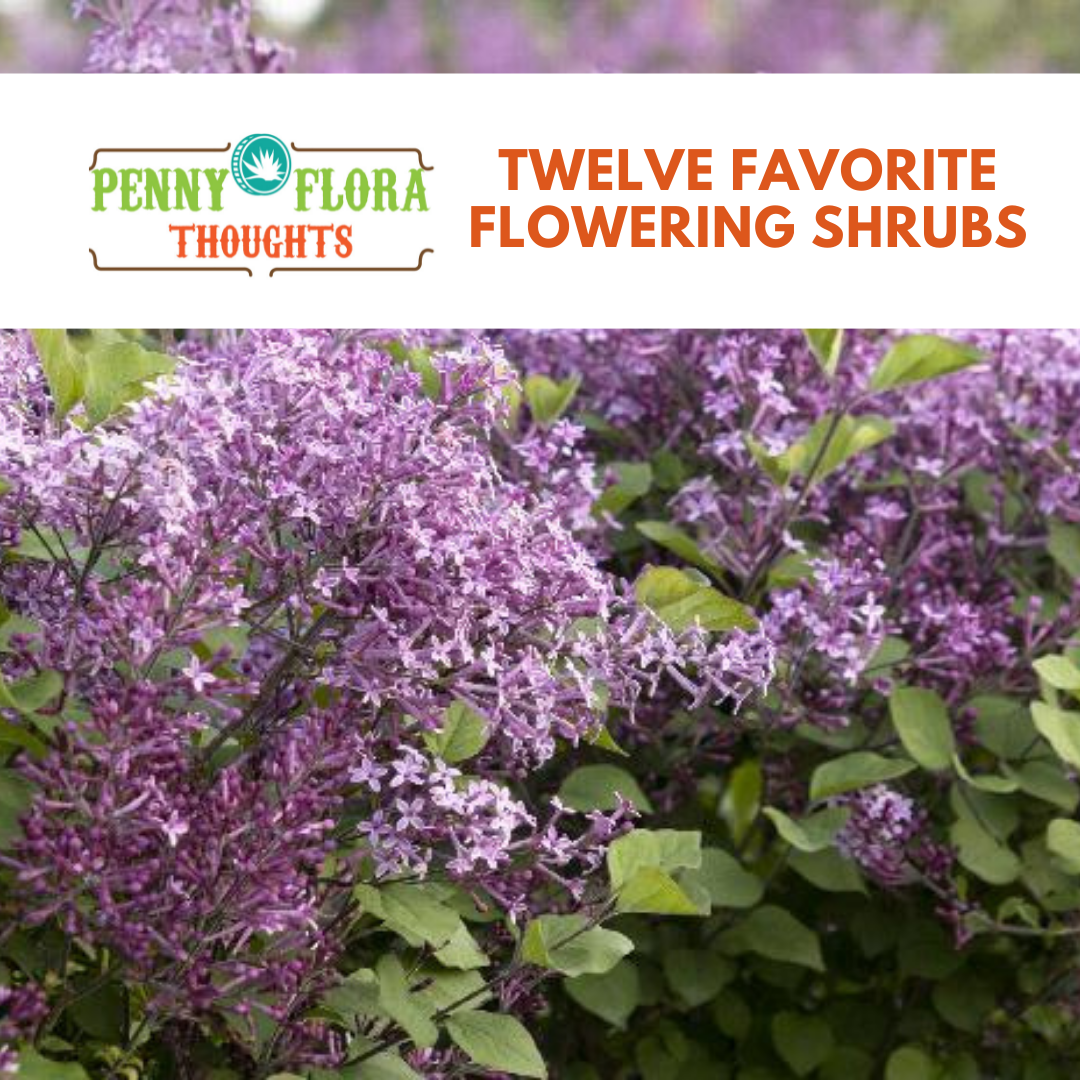If you’re looking for color in the garden, flowering shrubs are an easy answer. We love their beautiful blooms, not to mention, their height, structure and pollinator appeal they bring to the landscape. Some are fragrant and others have showy fall berries or colorful fall foliage. Here are 12 favorites.
-
Panicle Hydrangeas (Hydrangea paniculata) – Of all the hydrangeas, panicle hydrangeas are our top pick for their large conical blooms, winter toughness and flexibility from full to part-shade locations. You’ve probably heard of ‘Limelight’ (6’-8’) for its showy, lime green blooms. We also like ‘Quick Fire’ for its earlier pink blooms, ‘Pinky Winky’ for its color-changing blooms from white to deeper pink. For smaller spaces, try ‘Little Quick Fire’ and ‘Bobo’ (both 3’-5’). Tip: leave hydrangeas’ dried blooms for winter interest then prune them back in early March.

- Oakleaf Hydrangeas (Hydrangea quercifolia) – Oakleaf hydrangeas do double-duty with their beautiful, elongated bloom clusters and their colorful fall oak-shaped leaves. Try the classic ‘Alice’ that can reach 12’. For double blooms, ‘Snowflake’ is a stunner. And for smaller gardens, check out ‘Ruby Slippers’ (5’) and PeeWee’ (3.5’). We’re also crushing on ‘Jetstream’ for its stunning fall color. Tip: Oakleafs welcome some afternoon shade and should only be pruned every three years after flowering.
- Snowball Viburnums (Viburnum opulus) – If you’re a fan of hydrangeas’ big summer blooms, try snowball viburnums (6’-8’) for similar spring flower clusters. They’re also known for their incredible fragrance and hedge applications. Other favorites in the large viburnum family include ‘Miss Kim’ with fragrant pink clusters and ‘Blue Muffin,’ a native arrowwood cultivar with nectar-rich spring flowers and blue fall fruits (if planted near a different viburnum variety). cardinals, Eastern bluebirds, robins and cedar waxwings will thank you.
-
Weigela (Weigela florida) – With their funnel-shaped flowers, weigelas (4’-5’) are beloved by hummingbirds and bumblebees. They range in color from deep pink to yellow. Use them as accent plants in a mixed border or mass plant them for dramatic effect. Our two favorites are 1) ‘Wine and Roses’ with a romantic combo of rosy-pink flowers and dark glossy foliage and 2) ‘Sonic Bloom’ with a flush of hot pink blooms in May then waves of additional blooms until frost.

- Bottlebrush Buckeye (Aesculus parviflora) – Native to southeastern states, this shrub makes a statement in the garden with its long, fluffy white flower clusters. They bloom in early July and attract plenty of hummingbirds and butterflies including the Eastern tiger swallowtail. The shrubs thrive in shade to part-shade, so plant them in a woodland garden or at the edge of a woods with plenty of room to grow (6’-12’). Like other buckeyes, these shrubs feature the classic hand-shaped leaves yet bear more pear-shaped fruits rather than shiny round nuts.
-
Lilac (Syringa) – This old-time favorite has incredibly fragrant purple flowers that open in May. Plant them in full sun and prune as needed after flowering. The shrubs can last for decades. Besides the common lilacs, our favorites include dwarf ‘Bloomerang’ (4’-5’) that blooms in late spring and again in mid-summer through fall. To extend the show, add a Korean lilac like ‘Miss Kim’ (6’-8’) or ‘Baby Kim’ (2’-3’) with lighter lavender-colored flowers that bloom slightly later

- Ninebark (Physocarpus opulifolius)– Button-like flower clusters line the arching branches of these native shrubs in late spring. The newer cultivars feature colorful foliage ranging from gold to burgundy. Ninebarks thrive in sun to part shade. Try the dwarf Tiny Wine series (3’-5’) in burgundy, ginger and gold. Tip: After flowering, selectively prune one third of the branches to the ground to rejuvenate and improve air circulation.
-
Itoh Peony (Paeonia)– Also called “intersectional peonies,” Itohs are a cross between perennial and tree peonies made by Japanese horticulturist Dr. Toichi Itoh. Like tree peonies, they have large, long-lasting blooms and strong stems that don’t need staking. They also have dark green, lush, deeply lobed foliage. Plant them in full sun to part shade in rich, well-drained soil. Deadhead blooms as needed, and cut back to 4”-6” in fall.

-
Elderberry (Sambucus racemosa) -- This North American native produces big clusters of white flowers in early spring before its lacy leaves emerge. The shrub grows into a large plant (4’-7’) and can be pruned to stay smaller if you like. We prefer the ‘Lemony Lace’ with its lemon-lime foliage and red berries (for the birds).

-
Summersweet (Clethra alnifolia) – Bees and other pollinators love summersweet’s bottlebrush flowers in white, pink and rose. Plant them near a deck or patio to enjoy their mid-summer blooms and wonderfully spicey fragrance. While summersweet (3’-6’) prefer part shade and moist soil, they adapt to a range of conditions. Try ‘Ruby Pink’ with dark pink blooms or ‘Vanilla Spice’ in white.

-
Northern Spicebush (Lindera benzoin) – Called the “forsythia of the wilds,” this native shrub (8’-12’) features early spring clusters of dainty yellow flowers on bare twigs before its leaves emerge. It’s a host plant for spicebush swallowtail, Eastern tiger swallowtail and promethea silkmoth. Plant it to naturalize in woodlands, especially as a replacement for invasive bush honeysuckle.

- Eastern Wahoo (Euonymus astropurpureus) -- This tree-shrub (12’-20’) features charming red spring flowers and red fall berries making it an excellent food source for native insects and birds. Also, the red fall foliage makes it an excellent substitute for related yet invasive, non-native burning bush shrubs.
To learn more about these and other flowering shrubs, visit arboretums in person and check out their websites. A few of our go-tos include Morton Arboretum (Chicago), Dawes Arboretum (Newark, OH), Holden Arboretumv (Kirtland, OH) and Missouri Botanical Garden (St. Louis, MO).
*Photos courtesy of Monrovia


5 comments
Looking for lacecap Hydrangeas
We bought an elderberry bush there last year or the year before my husband has just loved this beautiful bush and our yard guy hit it with his mower and destroyed several branches. Do you have any more ?
Cathy
I have two perennial plants I bought from you last summer. I love them! People keep asking me what they are and I can’t find the name card in my stack of plant name cards that I bought last year. It is a green leafed plant that has white polka dots on the leaves. This spring it has tiny purple and pink flowers on it. It didn’t have any flowers when I bought them last summer, so I was very pleasantly surprised! Can you help me with the name of the plant? I live three hours away so I can’t just stop in and ask you by showing you a picture I have of the plant. Thanks!
If it’s printed copy 419 west main st crestline ohio 44827
Do you have a catalog